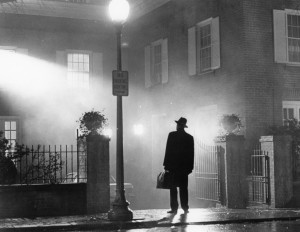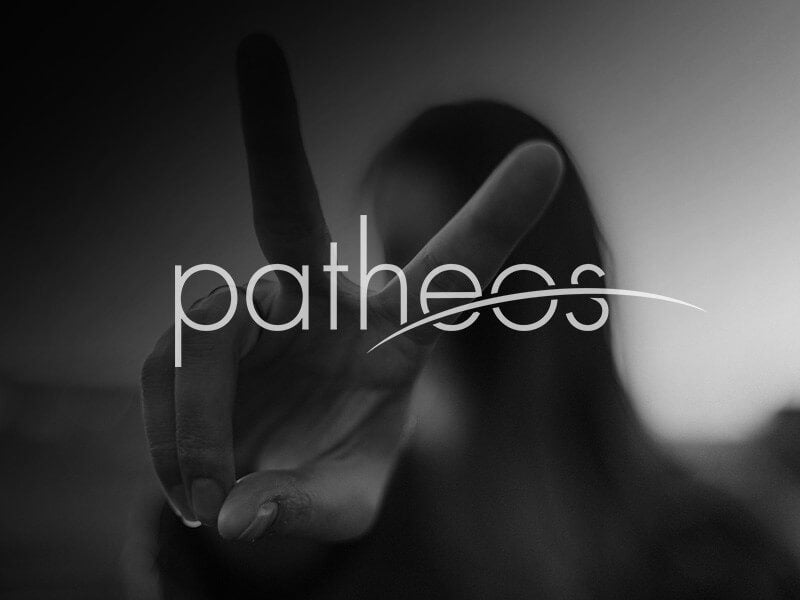William Friedkin’s The Exorcist turned 40 years old last year. Like Kubrick’s 2001, The Exorcist, adapted from William Peter Blatty’s novel by the author himself, remains effective filmmaking even as its most stunning moments have lost some of the shock of novelty that first generation audiences experienced. Great movies treat visual effects and set pieces as means rather than ends. The Exorcist is ultimately a film about human ideas, like belief, the problem of evil, and spirituality in postmodern age.
The key to understanding The Exorcist is to ask to whom the title refers. Casual audiences will say it certainly refers to Father Lancaster Merrin (Max Von Sydow). Merrin is, after all, the elderly priest depicted in The Exorcist’s iconic poster. That’s a famous shot, not least because it gives us a glimpse of a man emanating light into a cavern of darkness. But it’s significant that we don’t see the priest’s face in that image, nor do we actually see him in the process of exorcising Regan’s (Linda Blair) demon. Once again, we open the question of who “the exorcist” actually is.
The answer, not revealed till the movie’s climax, is Father Karras (Jason Miller, in a performance undeservingly forgotten). Karras is the priest who confesses early in the movie that he’s losing his faith. Between being wrecked with guilt and nightmares about his elderly mother, and lacking answers for his fellow priests’ personal troubles (Karras is a certified psychologist), Karras is suspecting that Christianity holds out no real hope for him after all.
Karras is, of course, the one who ultimately succeeds in defeating Regan’s demon. Seeing that Merrin has died in the priests’ penultimate confrontation with the spirit, Karras flies into a rage and demands that the demon possess him instead of Regan. When the demon obliges, Karras commits suicide rather than allow it to work through him, thus defeating it. Like Syndey Carton, Karras’s sacrifice is driven by guilt and a sense of unworthiness. Yet it’s important that none of Merrin’s exorcising rituals subdue Regan’s demon, while Karras’s self-surrender does.
Blatty is trying to tell us something there. There’s a deep, Gospel imagery that pervades the defeat of the demon. The New Testament teaches that Christ laid down his own life so as to let the sins of the world fall upon him. By giving himself up for others, Christ becomes victorious. That is the inverted logic of the Christian faith—the meek inherit the world, the weak shame the strong, and those who die live forever. The true exorcist is not the spiritual giant, it is the confused, doubting vessel through whom grace comes to Regan.
Consider how similar the world of The Exoricst is to our own. Regan’s mother (Ellen Burnstyn) is an actress, an atheist, and divorced, recalling postmodern culture’s obsession with entertainment, irreligion, and sexual autonomy. In our consumerist existence, no vocabulary remains for describing spiritual warfare, which is why Chris initially refuses to have Regan undergo an exorcism. This reminds us of our own generation’s aversion to explicitly religious answers. Vague notions of spirituality are en vogue but only because they too are easily commodified in a materialist worldview. Mentioning “enlightenment” or “meditation” is non-threatening and can be accommodated by any number of pluralism-friendly things. Demonic possession, however, requires a more solid theological framework.
It would probably be a mistake to understand The Exorcist as some sort of apologetic for Christianity in the postmodern age. Yet it is undeniably a masterpiece of religious cinema, and far more didactic in tone than is usually granted (a monologue by Merrin about the demon’s attempt to distort understanding of God’s love was edited out of the original theatrical release, but put back in for the re-release). It’s also a truly scary film; despite Regan’s horrifying disfigurements, the enemy is always invisible, manipulating his victims while remaining just out of reach.
The Exorcist inspires us to consider the sharpest points of tangency between an unbelieving world and the claims of the Gospel. It is a story about the problem of evil, asking why an innocent girl like Regan should be subjected to spiritual and physical torture. In our own age, we find ourselves asking similar questions about why the world is as evil and dysfunctional as it is. Tempted though we may be to reach for purely human answers (whether they are economic inequality, lack of education, et al), Christians must drink from their own worldview and insist that no aspect of human existence precludes spiritual reality. Being made in the image of God means it is impossible for any human being to opt-out of spiritual warfare.
And yet, the Gospel teaches that God himself has crushed Satan and his works. The weapon of the enemy is sin, which the Son of God absorbed himself on behalf of all those who believe. The final victory belongs to God, and we rest confident that we share in that victory every day until the end of the age.
The Exorcist is cinema that can awaken us out of a materialist slumber and make us consider once again the struggle between light and dark. If our witness is to have any effectiveness in a “post-Christian age,” it must return to the elemental principles of our faith. Those who know Christ are not guaranteed a lifetime of evasion from darkness, only that when the darkness comes, the path of light will be won for them.












